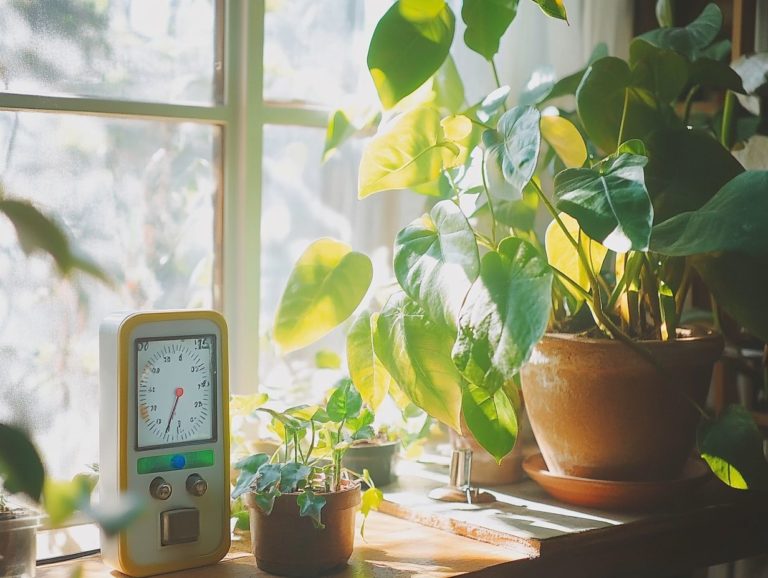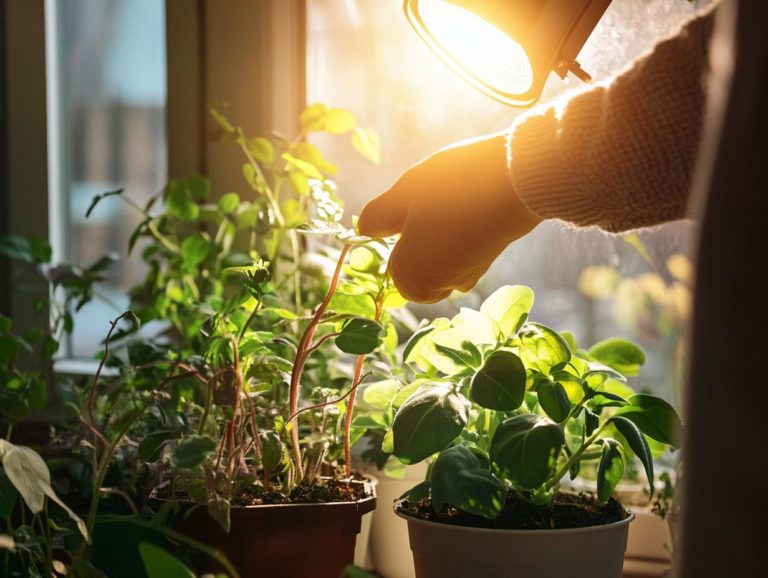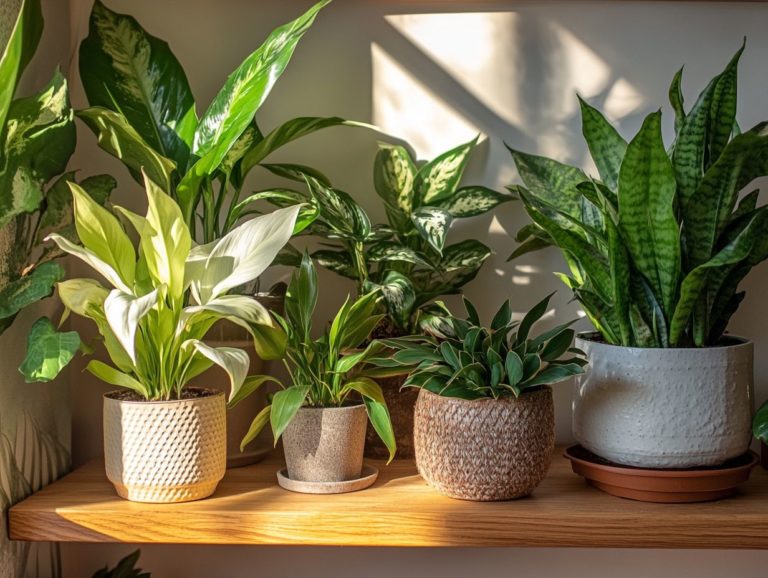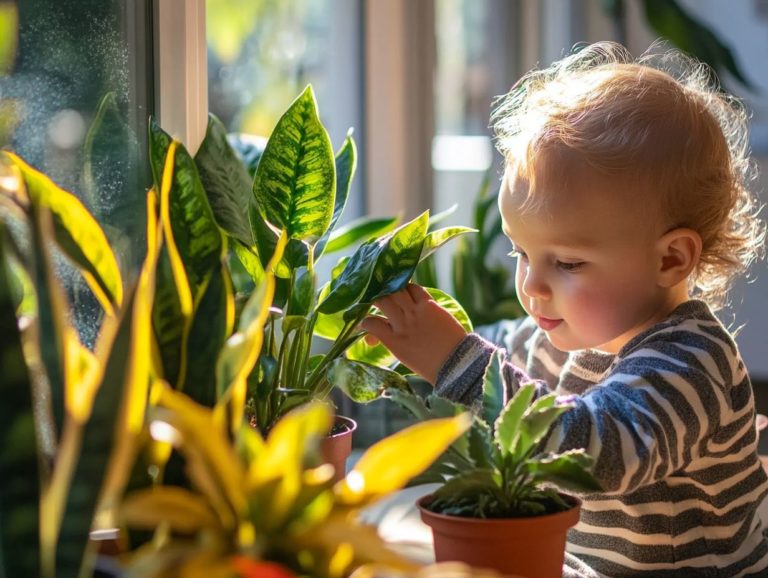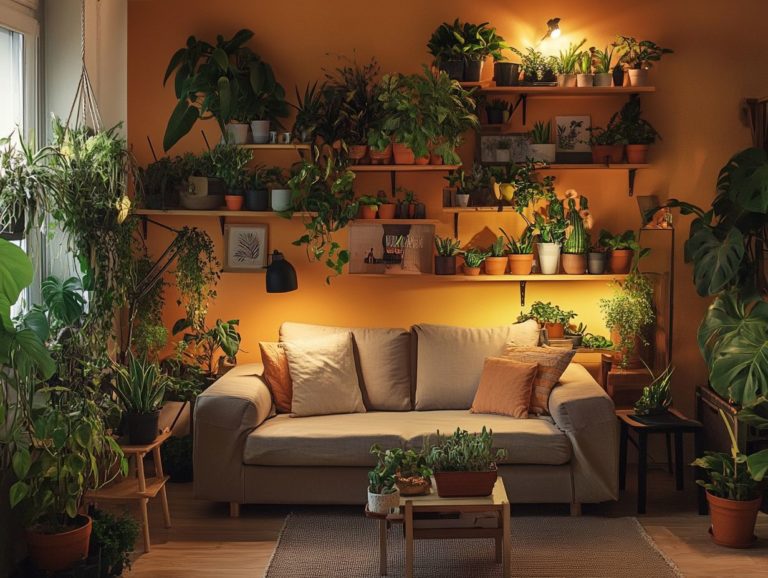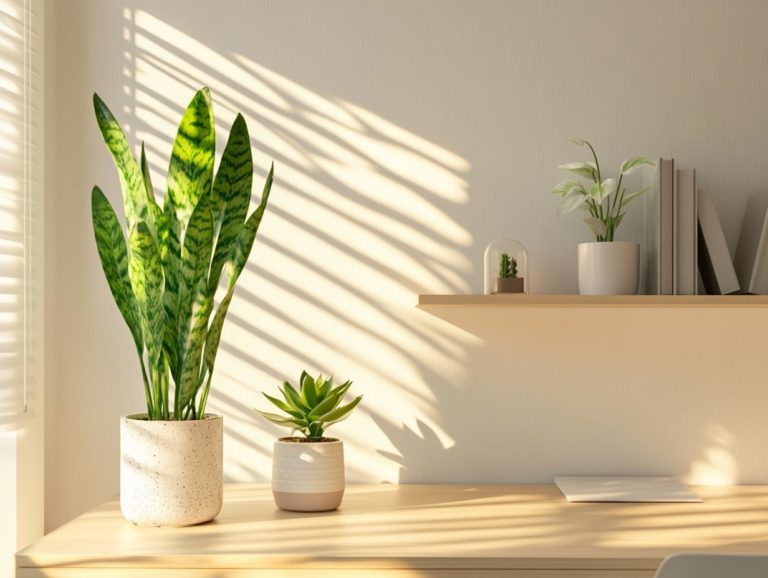How Often Should I Water My Indoor Plants?
Indoor plants can truly transform any space, infusing it with life and vibrancy. However, grasping their specific watering needs is crucial for ensuring they remain healthy and thrive.
This guide will walk you through the various factors that dictate how often to water your plants, the signs that indicate whether they re thirsty or perhaps a bit too soggy, and practical tips for establishing a consistent watering schedule.
Whether you’re tending to succulents or tropical plants, you’ll uncover best practices and techniques tailored to suit different varieties of greenery.
You’ll also find essential tools and methods to help you maintain the ideal moisture levels, even as the seasons shift. Discover how to nurture your indoor garden with ease and elegance!
Contents
- Key Takeaways:
- Understanding Your Indoor Plants
- Signs of Underwatering and Overwatering
- Determining the Right Watering Schedule
- Watering Techniques for Different Types of Plants
- Tips for Consistent Watering
- Adjusting Watering Frequency Based on Season
- Frequently Asked Questions
- How often should I water my indoor plants?
- How do I know when my indoor plants need to be watered?
- Can I water my indoor plants on a set schedule?
- What is the best way to water my indoor plants?
- How can I prevent overwatering my indoor plants?
- What should I do if I accidentally underwater my indoor plants?
Key Takeaways:
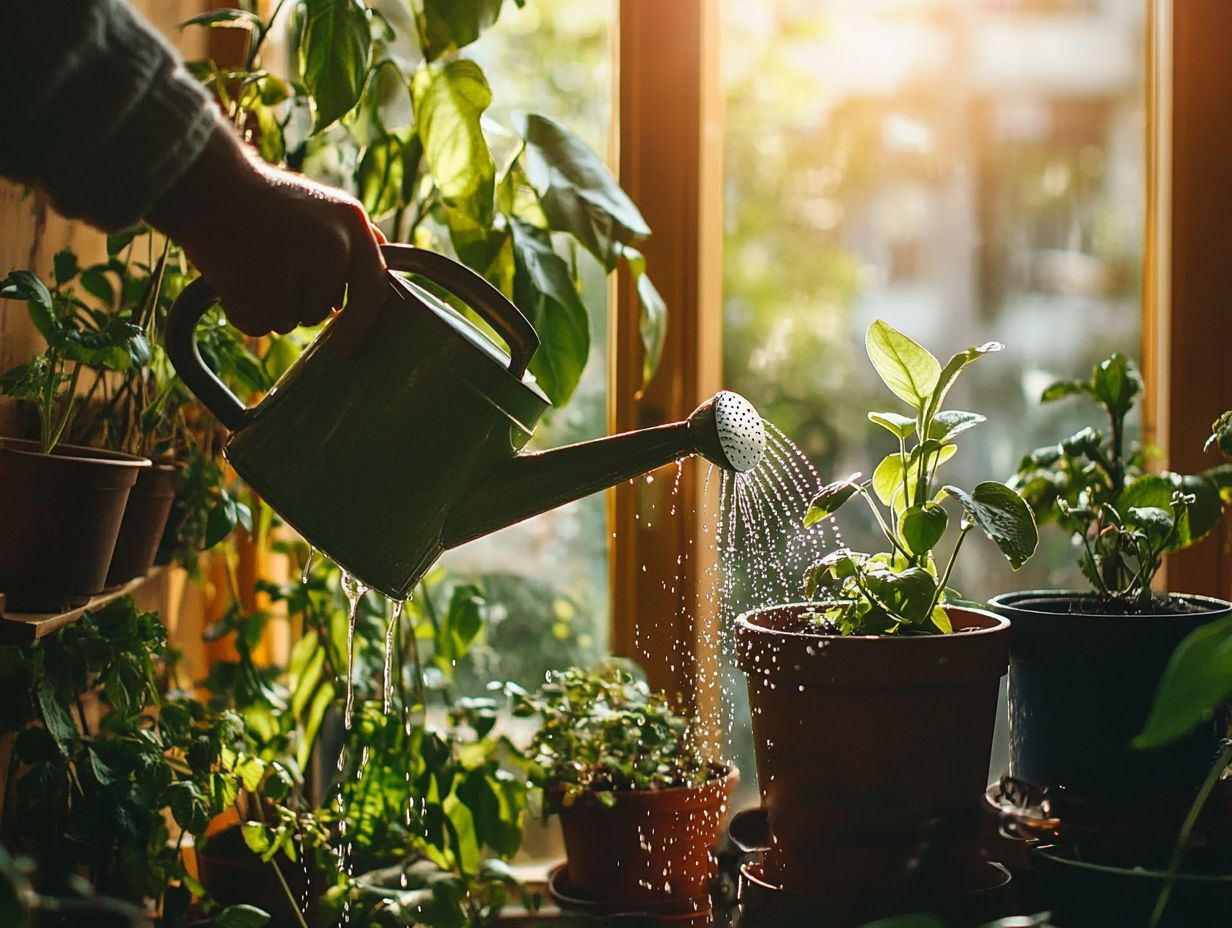
- Know your plants! Understand their type, size, and environment.
- Watch for signs of thirst or too much water.
- Make a watering schedule and adjust it with the seasons.
Understanding Your Indoor Plants
Grasping the nuances of your indoor plants is crucial for their health and vibrancy. By looking into their specific needs, you can cultivate an environment that fosters growth and well-being.
Think about factors like light exposure, room temperature, humidity levels, and soil types; these elements significantly influence how you care for diverse plant varieties, from resilient succulents to lush tropical species such as the Peace Lily and Monstera deliciosa.
Being attentive to your plants’ behavior helps you recognize signs of distress, allowing you to implement timely and effective interventions.
Factors that Affect Watering Needs
Several factors significantly influence the watering needs of your indoor plants, such as soil moisture, holes at the bottom of pots that let excess water escape, and seasonal shifts in temperature and humidity. Understanding these elements is key to creating a good watering schedule that keeps your houseplants thriving.
For instance, tropical plants typically crave more moisture than succulents, and the type of soil can dictate different watering habits based on your plant’s specific requirements.
The size and type of pot you choose are crucial in determining how quickly the soil retains moisture, which directly affects how often you need to water. A larger pot may hold water longer, while a smaller one can dry out rapidly, prompting you to check on it more frequently.
It’s also vital to keep an eye on your local climate and indoor conditions. Homes with central heating or air conditioning can create drier environments, impacting moisture loss.
Therefore, regularly assessing each plant s unique characteristics, along with making seasonal adjustments, helps you adopt a personalized approach that fosters robust growth and vitality.
Signs of Underwatering and Overwatering
Recognizing the signs of underwatering and overwatering is essential for maintaining the health of your indoor plants. When you underwater, you might notice wilted leaves and dry soil, signaling that your plants are thirsty.
On the other hand, overwatering can lead to root rot and yellowing leaves, which is a whole different kind of trouble. To keep your plants thriving, consider using a moisture meter; this handy tool allows you to accurately gauge soil moisture levels.
By doing so, you can establish a tailored watering routine that meets each plant’s unique needs, helping you prevent distress signals before they escalate.
How to Identify and Address Issues
Identifying and addressing issues related to watering is crucial for maintaining the health of your indoor plants. Start by observing growth signs like leaf discoloration or drooping. These may signal improper watering habits.
Implement personalized tips for each plant type to avoid common pitfalls such as overwatering or insufficient hydration. This ensures your houseplants receive the exceptional care they deserve.
To address these issues effectively, experts like Andrea Beck recommend establishing a routine that includes checking soil moisture before watering. A simple finger test can quickly reveal whether the top inch of soil is dry.
For those plants that require a bit more attention, she suggests creating a moisture tracker, a simple chart to track when you water your plants. Joseph Tychonievich highlights the importance of using well-draining pots and soil mixes to prevent waterlogging, which can lead to root rot.
Consider pairing up with a friend for plant swaps; this can offer valuable insights and shared experiences. Always keep in mind that each plant has its unique needs, so be ready to adapt your approach for sustainable plant care.
Determining the Right Watering Schedule
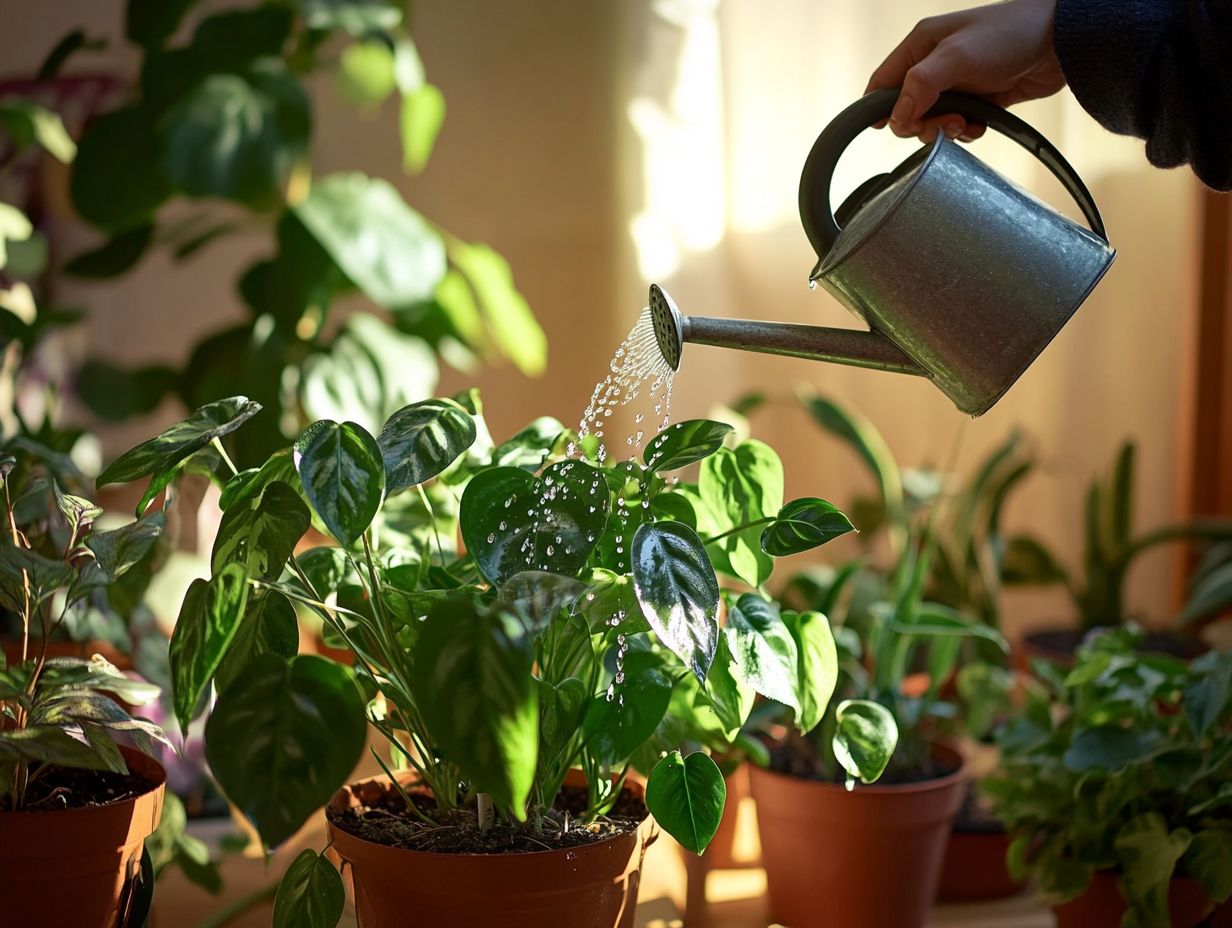
Establishing the ideal watering schedule is essential for ensuring your indoor plants flourish all year round. You’ll want to consider each plant’s unique requirements, their exposure to light, and their growth patterns. These elements will significantly impact how often you need to water.
For example, tropical plants typically demand more frequent watering compared to succulents. Utilizing self-watering planters, pots that automatically provide water to plants, can be an excellent strategy for maintaining consistent moisture levels, especially during seasonal shifts.
Factors to Consider
When establishing a watering schedule, consider several critical factors:
- Humidity levels
- Soil types
- Use of room temperature water
These elements directly influence how frequently and effectively you should water your indoor plants. Understanding how different soil types retain moisture and how water loss through leaves affects your plants will guide you in optimizing your watering habits.
To start, monitoring humidity in your home can significantly impact your watering frequency. For instance, plants in drier environments may require more frequent watering compared to those thriving in more humid conditions.
Recognizing the type of soil where your plants are rooted is equally essential; well-draining soil allows for faster moisture loss, meaning you ll need a more rigorous watering schedule.
Using room temperature water is a simple yet effective way to prevent shocking the plant’s root system, thereby promoting better absorption. By considering these factors, you’ll be able to create a tailored watering routine that perfectly meets the specific needs of your indoor greenery.
Watering Techniques for Different Types of Plants
Employing different watering techniques is crucial for addressing the specific needs of various plant types, whether you re nurturing tropical plants or succulents.
While top watering is a widely practiced method, bottom watering offers significant advantages. This technique allows the roots to absorb just the right amount of moisture without the risk of overwatering.
By mastering these techniques, you can elevate your plant care routine and foster healthier growth in your indoor plants, including Philodendrons and ZZ plants.
Best Practices for Succulents, Tropical Plants, and More
Implementing best practices for watering can profoundly influence the health of your indoor plants. This is particularly important when distinguishing between succulents, tropical plants, and other houseplants. Understanding the quality of water you use is crucial; your choice can significantly affect the roots and overall growth of your plants.
By observing signs of distress and adjusting your watering techniques accordingly, you can ensure that each type of plant flourishes in your indoor garden.
It’s essential to customize your approach based on the unique hydration needs of each plant. Succulents, for example, prefer sparse watering allowing the soil to dry out completely between sessions while tropical plants thrive on consistent moisture, benefiting from more frequent watering.
Be vigilant for telltale signs of overwatering, such as yellowing leaves or root rot. Act quickly if you see yellowing leaves; it could be a sign of overwatering! Recognizing these early warning signs can save your greenery from irreversible damage.
Conversely, if a plant’s leaves appear droopy or crispy, consider increasing the humidity or the frequency of your watering to create a more favorable environment.
Tips for Consistent Watering
Consistency in watering is essential for maintaining the health of your indoor plants. Adopting a few simple strategies can significantly elevate your plant care routine.
Using a moisture meter allows you to measure how wet the soil is, helping you avoid the pitfalls of both overwatering and underwatering.
Cultivating strong watering habits based on your understanding of each plant helps you customize your care, ensuring they flourish beautifully.
Tools and Methods for Maintaining Proper Moisture Levels
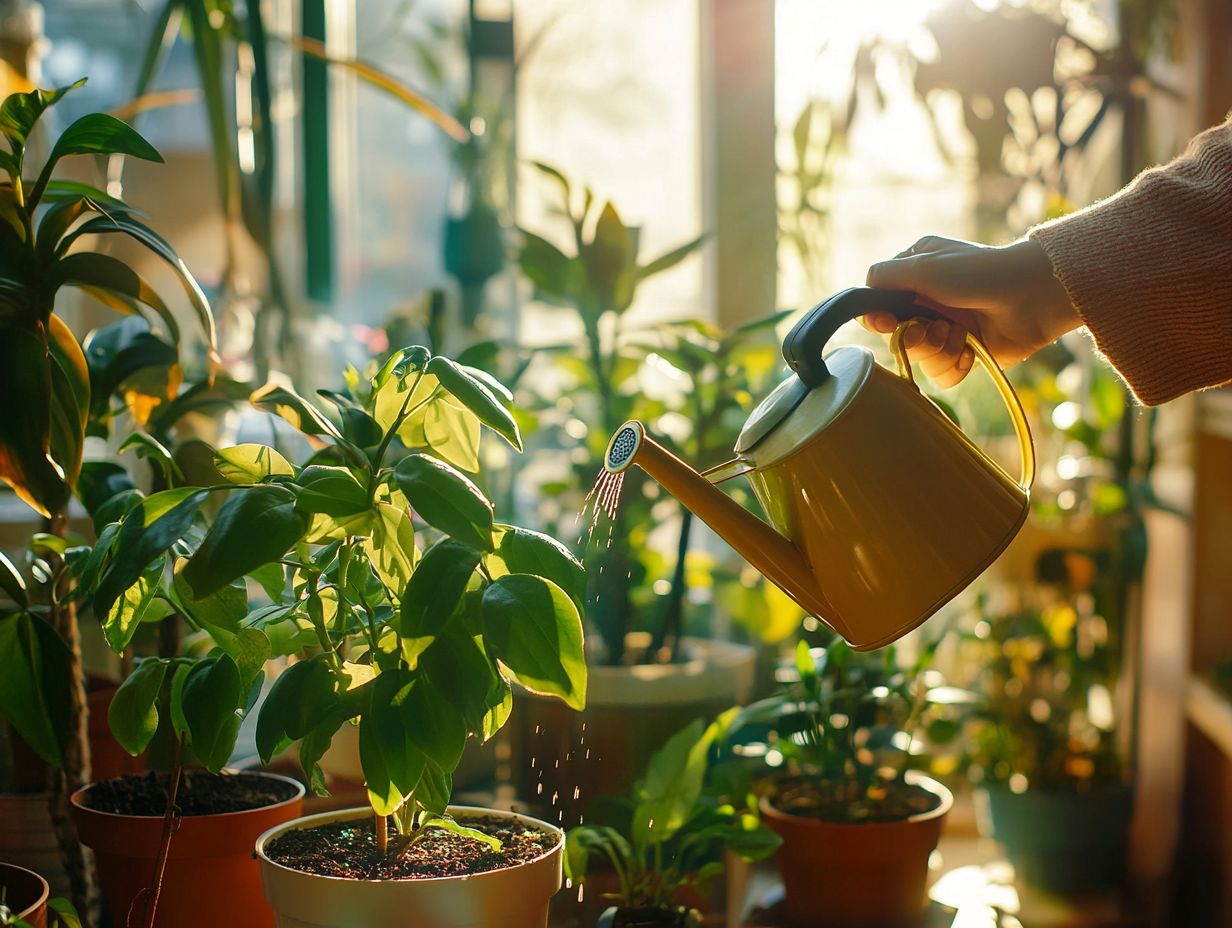
Utilizing the right tools and methods to maintain proper moisture levels is crucial for the health of your indoor plants. By investing in a quality watering can and understanding the significance of water quality, you can enhance your watering techniques.
For those with busy lifestyles, self-watering planters present a practical solution, providing a consistent supply of moisture that caters to various plant needs.
Among the array of tools at your disposal, moisture meters are invaluable for accurately gauging soil hydration levels. They help you avoid the perils of over or under-watering. While they can be quite handy, remember they may require calibration and can sometimes give misleading readings, especially in denser soil types, which can affect plant behavior.
Drip irrigation systems, which automatically water your plants directly at the roots, offer an efficient approach. This optimizes nutrient absorption and promotes healthier growth. Although the initial setup cost can be steep, and they may need occasional maintenance, the benefits are undeniable.
By thoughtfully combining these tools to meet your plants’ specific requirements, you can dramatically elevate your plant care regimen while adhering to watering guidelines.
Adjusting Watering Frequency Based on Season
Adjusting your watering frequency according to the seasons is essential for the health of your indoor plants. As temperatures shift, the humidity levels and moisture requirements of various plant types also change.
For instance, succulents often need less frequent watering during winter, while tropical plants may demand more attention as humidity rises in the warmer months. This highlights the importance of adapting your houseplant care routine throughout the year to ensure their optimal growth and health.
Apply these tips to ensure your plants thrive!
How to Adapt to Changing Environmental Conditions
Adjusting to environmental changes is key to thriving indoor plants. Light and humidity affect how you water your plants. By monitoring growth signs and observing your plants behavior, you can determine if adjustments are necessary. This ensures your houseplants receive the precise amount of moisture and care they need throughout the seasons, leading to fewer common mistakes.
Regularly check for pests. Look for signs of disease, as both can hurt your plants. Different types of plants have specific humidity and light needs; for instance, tropical plants thrive in higher humidity, while succulents prefer drier environments.
Establishing a routine of weekly or bi-weekly inspections will enable you to intervene promptly when needed, ensuring your plants receive the best water and care. Tools like moisture meters can provide accurate readings of soil moisture, helping you fine-tune your watering schedule. This approach helps your plants survive and thrive, allowing you to enjoy vibrant, healthy plants and enhances your overall plant knowledge throughout the year.
Frequently Asked Questions
How often should I water my indoor plants?
The frequency of watering your indoor plants depends on factors such as the type of plant, the size of the pot, and the environment it is placed in, including the room temperature water you use. Generally, most plants need watering once or twice a week.
How do I know when my indoor plants need to be watered?
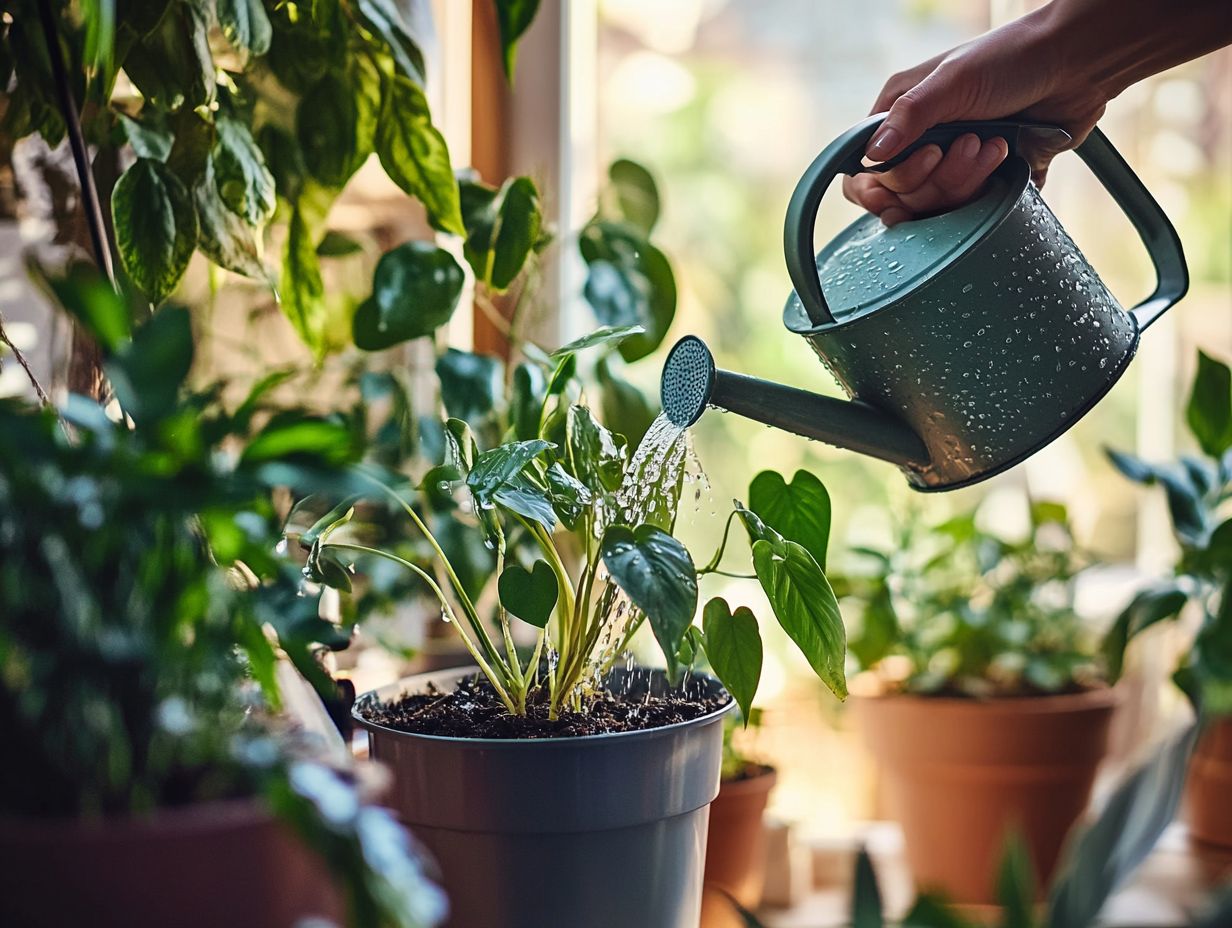
A good way to check if your indoor plants need watering is by feeling the soil. If the top inch of the soil is dry, then it’s time to water. You can also use a moisture meter to accurately measure the moisture level of the soil.
Can I water my indoor plants on a set schedule?
While it may seem convenient to water your indoor plants on a set schedule, it’s not recommended since watering guidelines should adapt to changing conditions. The watering needs of plants can change depending on factors like temperature and humidity, so check the soil moisture before watering.
What is the best way to water my indoor plants?
The best way to water indoor plants is by giving them a thorough soak until water drains out of the bottom of the pot, which supports proper drainage holes. This ensures that the entire root system is watered. Avoid misting or lightly spraying plants as this may not provide enough water.
How can I prevent overwatering my indoor plants?
Overwatering can be harmful to indoor plants, causing root rot and other issues. To prevent overwatering plants, make sure the pot has adequate drainage holes, use a suitable potting mix, and check the moisture level of the soil before watering. You can also use a watering schedule based on the needs of each individual plant.
What should I do if I accidentally underwater my indoor plants?
If you accidentally underwater your indoor plants, act quickly to revive your plants and avoid shock! Give them a deep soak using bottom watering techniques as soon as possible. Keep an eye on the plants and adjust your watering schedule accordingly to promote overall health.

